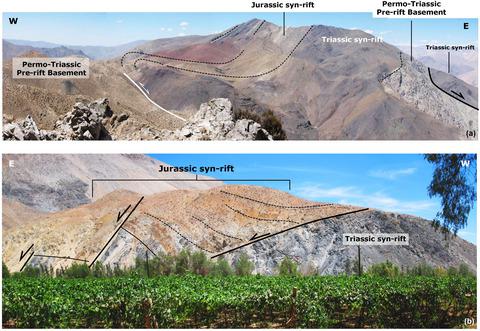当前位置:
X-MOL 学术
›
Basin Res.
›
论文详情
Our official English website, www.x-mol.net, welcomes your
feedback! (Note: you will need to create a separate account there.)
Contraction and exhumation of the western Central Andes induced by basin inversion: New evidence from “Pampean” subduction segment
Basin Research ( IF 2.8 ) Pub Date : 2021-06-27 , DOI: 10.1111/bre.12580 F. Martínez 1 , M. Peña 2 , M. Parra 3 , C. López 1
Basin Research ( IF 2.8 ) Pub Date : 2021-06-27 , DOI: 10.1111/bre.12580 F. Martínez 1 , M. Peña 2 , M. Parra 3 , C. López 1
Affiliation

|
In this study, we conducted an integrated analysis supported by previous regional and mesoscopic field observations, new U–Pb chronological data of synorogenic deposits and thermochronological data from syncontractional granitic rocks. The objective is understanding the main mechanism and timing of crustal uplift of the western Central Andes on the modern flat-slab segment of northern Chile. The first-order structural styles identified in several basins of northern Chile consisted mostly of large reverse-reactivated Mesozoic normal faults, which formed large kilometer-scale inverted anticlines and localized doubly verging basement reverse faults depending on the degree of tectonic inversion. The observations indicate that crustal shortening experienced in the region was distributed along with the pre-orogenic half-graben structures of the Triassic to Jurassic basement. The wide distribution of Upper Cretaceous–Paleocene synorogenic deposits over the syn-rift Mesozoic deposits along inverted structures in both the Coastal and Frontal cordilleras indicate that the Andean orogenesis in the region was initiated during this period. Our field and geochronological interpretations suggest that basin inversion of the ancient Mesozoic half-graben structures was frequently accompanied by the emplacement of Upper Cretaceous and Paleocene intrusive granitic bodies hosted in the core of the anticline and syncline folds. Their crystallization ages correlated with those reported by the synorogenic deposits, thereby suggesting that both basin inversion and magmatism occurred simultaneously. The thermal history of the intrusives also indicates that they were rapidly exhumed at 53‒57 Ma, possibly during the final episodes of the basin inversion.
中文翻译:

盆地反转引起的中西部安第斯山脉的收缩和剥脱:来自“潘潘”俯冲段的新证据
在这项研究中,我们进行了综合分析,这些分析得到了先前的区域和细观野外观测、共生矿床的新 U-Pb 年代学数据和同收缩花岗岩的热年代学数据的支持。目的是了解智利北部现代平板段上安第斯山脉中西部地壳隆升的主要机制和时间。智利北部几个盆地发现的一级构造样式多为大型逆再活动的中生代正断层,根据构造反转的程度,形成了大千米级的倒背斜和局部双缘基底逆断层。观测表明,该地区经历的地壳缩短与三叠纪至侏罗纪基底的造山前半地堑结构一起分布。上白垩统-古新世同造矿床在沿海岸和前缘山脉的倒置构造的同裂谷中生代沉积物上的广泛分布表明该地区的安第斯造山作用是在这一时期开始的。我们的野外和年代学解释表明,古中生代半地堑构造的盆地反转经常伴随着位于背斜和向斜褶皱核心的上白垩统和古新世侵入花岗岩体的就位。它们的结晶年龄与共生沉积物报告的结晶年龄相关,从而表明盆地反转和岩浆活动同时发生。侵入体的热历史也表明它们在 53-57 Ma 时被迅速挖掘,可能是在盆地反转的最后阶段。
更新日期:2021-09-03
中文翻译:

盆地反转引起的中西部安第斯山脉的收缩和剥脱:来自“潘潘”俯冲段的新证据
在这项研究中,我们进行了综合分析,这些分析得到了先前的区域和细观野外观测、共生矿床的新 U-Pb 年代学数据和同收缩花岗岩的热年代学数据的支持。目的是了解智利北部现代平板段上安第斯山脉中西部地壳隆升的主要机制和时间。智利北部几个盆地发现的一级构造样式多为大型逆再活动的中生代正断层,根据构造反转的程度,形成了大千米级的倒背斜和局部双缘基底逆断层。观测表明,该地区经历的地壳缩短与三叠纪至侏罗纪基底的造山前半地堑结构一起分布。上白垩统-古新世同造矿床在沿海岸和前缘山脉的倒置构造的同裂谷中生代沉积物上的广泛分布表明该地区的安第斯造山作用是在这一时期开始的。我们的野外和年代学解释表明,古中生代半地堑构造的盆地反转经常伴随着位于背斜和向斜褶皱核心的上白垩统和古新世侵入花岗岩体的就位。它们的结晶年龄与共生沉积物报告的结晶年龄相关,从而表明盆地反转和岩浆活动同时发生。侵入体的热历史也表明它们在 53-57 Ma 时被迅速挖掘,可能是在盆地反转的最后阶段。











































 京公网安备 11010802027423号
京公网安备 11010802027423号